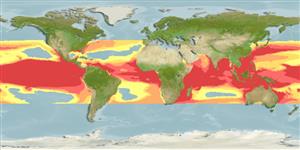Teleostei (teleosts) >
Carangiformes (Jacks) >
Carangidae (Jacks and pompanos) > Caranginae
Etymology: Uraspis: Greek, oura = tail + Greek, aspis = shield (Ref. 45335).
More on author: Poey.
Environment: milieu / climate zone / depth range / distribution range
Ecology
Marine; pelagic-oceanic; oceanodromous (Ref. 51243); depth range 1 - 50 m (Ref. 89972), usually 2 - 15 m (Ref. 40849). Subtropical; 42°N - 34°S, 180°W - 180°E
Worldwide in warm waters. Western Indian Ocean: Tanzania (Ref. 3287, 3197). Eastern Central Pacific: California, USA to Costa Rica (Ref. 2850). Also in Hawaii. Western Atlantic: Massachusetts, USA and northern Gulf of Mexico to Brazil. Eastern Atlantic: Mauritania to Angola (Ref. 7097); also Algoa Bay, South Africa (Ref. 3197).
Size / Weight / Age
Maturity: Lm ? range ? - ? cm
Max length : 50.0 cm TL male/unsexed; (Ref. 7251); common length : 40.0 cm TL male/unsexed; (Ref. 26999); max. published weight: 2.0 kg (Ref. 40637)
Adults are mostly oceanic and pelagic but sometimes found near the bottom, often near islands. Solitary or in small schools (Ref. 2850).
Life cycle and mating behavior
Maturity | Reproduction | Spawning | Eggs | Fecundity | Larvae
Smith-Vaniz, W.F., J.-C. Quéro and M. Desoutter, 1990. Carangidae. p. 729-755. In J.C. Quero, J.C. Hureau, C. Karrer, A. Post and L. Saldanha (eds.) Check-list of the fishes of the eastern tropical Atlantic (CLOFETA). JNICT, Lisbon; SEI, Paris; and UNESCO, Paris. Vol. 2. (Ref. 7097)
IUCN Red List Status (Ref. 130435)
Threat to humans
Harmless
Human uses
Fisheries: minor commercial; gamefish: yes
More information
ReferencesAquacultureAquaculture profileStrainsGeneticsElectrophoresesHeritabilityDiseasesProcessingNutrientsMass conversion
Tools
Can't connect to MySQL database fbquizv2. Errorcode: Too many connections
